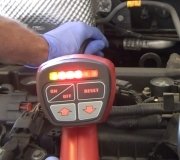Another clue to a leaking evaporator is if the air coming out of the ducts is too cold right after recharging the system. Pressure in the evaporator is carefully controlled to never go below around 40 pounds which coincidentally equates to 40 degrees. That is high enough to prevent the condensed water from freezing into a block of ice that would block air flow. When you blow a lot of 80 degree air through a 40 degree evaporator, you get 60 to 65 degree air from the ducts, which can be uncomfortably cold. If you stuff a thermometer in a center duct and find the air is colder than, ... Oh, ... Around 50 to 55 degrees, that is not due to air that's being cooled. That is due to escaping refrigerant. I have the same stuff in spray cans used to cool components in car radios and tvs when they're suspected of having a thermal failure. That stuff can get down to -60 degrees when it vaporizes. A properly-working AC system can not deliver air that is below about 60 degrees so if you find anything colder, follow the cold to the source of the leak.
Even a big leak in the evaporator can be hard to find with an electronic leak detector because first of all, pressures are higher in the "low side" of the system when it's turned off. The pressure in the entire system will be fairly close to outside air temperature, so let's say 80 degrees. That's when a leak in the evaporator is more likely to occur but the vapor is going to pool inside the heater box where the leak detector can't reach. When the system is running, the compressor pumps the high side, (under the hood) to a higher pressure so a leak there will get worse, and the vapors will be blown away by the radiator fan and not be detected. The pressure in the evaporator goes way down when the system is running, so a leak there will slow down or stop. Low-side leaks inside the cab typically get worse when the system is off, but the fan has to be run at a slow speed to blow the vapors out of the ducts.
To complicate it even more, by running the heater fan with the engine off, a leak under the hood can produce vapors that get drawn into the fresh air intake, blown through the evaporator, and come out the ducts where it can be falsely detected as an evaporator leak. Now you get an idea of why some leak locations can be so hard to find. That's where the dye is especially useful, as long as you can see where it's showing up.
Friday, February 24th, 2012 AT 10:12 PM



